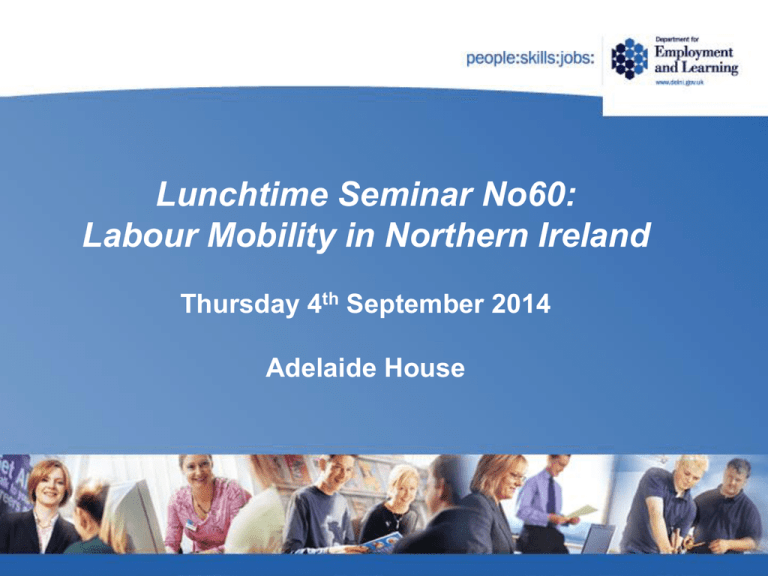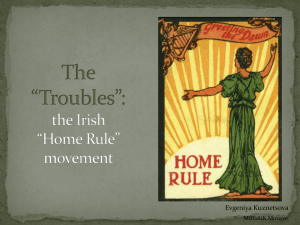Labour Mobility in Northern Ireland
advertisement

Lunchtime Seminar No60: Labour Mobility in Northern Ireland Thursday 4th September 2014 Adelaide House Research into labour mobility in Northern Ireland 4 September 2014 Introduction DEL commissioned Oxford Economics to undertake a comprehensive review of labour mobility in Northern Ireland The objectives of the study were to: 4 Review the factors that determine mobility Present evidence on the degree of mobility in Northern Ireland Identify barriers to mobility that may inhibit the efficient functioning of the labour market The study explores two types of labour mobility within Northern Ireland Labour market status mobility Geographic mobility Employment Nonemployment Economically inactive Frequency Full-time employee Commuting Time of day Transport availability Part-time employee Unemployed Selfemployed Primary focus (moves between non-employment and employment) Secondary focus (moves within employment status) Within NI Migration Beyond NI (outside scope) Geographical mobility is important, but too much may be inefficient and be associated with a lack of cohesion and a weakening of social capital Labour mobility benefits individuals and firms, and is a crucial component of Northern Ireland’s long-term economic competitiveness 6 Mobility enables individuals to improve their personal circumstances by moving into work Mobility enables firms to draw from a larger pool of potential workers Vacancies can be filled more quickly Better match between jobs and workers For Northern Ireland, greater mobility means: Reduced poverty and social exclusion Making the best possible use of the workforce Ability to quickly react to emerging technologies and commercial opportunities Greater long-term economic competitiveness Despite significant progress over the last two decades, the NI labour market continues to face structural challenges The claimant count unemployment rate fell steadily until 2008, but increased steeply during the recession 100% 90% 80% 70% 60% 50% 40% 30% 20% 10% 0% 12% 10% 8% 6% 4% 2% 0% 91 93 95 97 99 01 03 Northern Ireland 05 07 09 11 13 UK The proportion of the working age population claiming Disability Living Allowance is twice that in England and Wales 12% 10% 8% 6% 4% 2% 0% 2003 2005 2007 Northern Ireland 7 There has been a clear process of de-industrialisation over the last two decades 2009 2011 England and Wales 2013 91 93 95 97 99 01 03 05 07 09 11 13 Agriculture and Mining Industry Services Northern Ireland has the greatest reliance on public sector jobs amongst UK regions 0% Northern Ireland Wales North East Scotland South West Yorkshire & Humber North West West Midlands Uk East Midlands South East Eastern London 10% 20% 30% 40% The study used a range of sources and techniques A literature review by Dr Ian Shuttleworth of Queen’s University Belfast and Professor Anne Green of Warwick University Telephone survey with 1,100 non-employed individuals Focus groups with small groups of Job Club participants in Ballymena, West Belfast, Derry~Londonderry, Strabane Statistical analysis and modelling, including detailed analysis of the LFS Stakeholder interviews: JBO / JC Advisers in Ballymena, West Belfast, Derry~Londonderry and Strabane Employers (Ikea, a Belfast City Centre hotel, a Derry~Londonderry technology company) Disability Action, Gingerbread NI, Institute for Conflict Research, NI Community Relations Council, Supported Employment Solutions, Youth Council NI) Most of the work was completed between October 2013 and April 2014 8 Geographic mobility The drivers of geographical mobility in Northern Ireland are similar to those identified by wider academic research House moves Less mobile More mobile Aged 40+ Aged under 40 Lower skilled Daily commute With dependent children Previous experience of working/studying away from home No dependent children Aged 45+ Aged 25-44 Females Males Lower skilled Higher skilled Part-time employees Full-time employees Previous experience of commuting The Northern Ireland labour market is characterised by a clear East-West divide Employee jobs, workplace-based, 2011 Source: Northern Ireland Census of Employment 2011 Proportion of the population aged 16-74 that is nonemployed, 2011 Source: 2011 Census House moves are not an effective labour market adjustment mechanism in Northern Ireland Proportion of the of population aged 16+ who have moved house during the last three years, 2012 Source: Labour Force Survey, Oxford Economics Proportion of the population aged 16+ who have moved house during the last three years, 2004 to 2012 Source: Labour Force Survey, Oxford Economics People generally move within their local area and many are unwilling to relocate to take up work Average distance moved within Northern Ireland, 2001-2006 Average distance of move, miles Move to Rural area Urban area Rural area 2.3 16.4 Move from Urban area 15.1 2.9 Percentage of moves Move to Rural area Urban area Rural area 23% 4% Move from Urban area 6% 67% Source: Registrar General Northern Ireland Annual Report 2006 Would you be prepared to move to another part of Northern Ireland to obtain employment? Not sure 7% Yes 29% No 64% Source: PIMR telephone survey Commuting times in Northern Ireland are similar to other parts of the UK outside London Average travel to work time, all UK regions, 2012 Average travel to work time in Northern Ireland, 2006 to 2012 Source: Labour Force Survey, Oxford Economics Source: Labour Force Survey, Oxford Economics Northern Ireland is very car-dependent and few people travel to work by public transport Mode of transport to work, 2011 Proportion of workers commuting by public transport, 2011 Source: Census 2011 Source: Census 2011 Transport is a significant barrier to mobility Cost of travel means it is often not economically viable for those at the lower end of the labour market to travel to work “No car, no job; no job, no car” Car ownership by economic activity status Source: Census 2011 Transport is a significant barrier to mobility in Northern Ireland Job Seeker’s Agreement states an individual must be willing to travel 90 minutes to a job Even in Belfast, Ikea find it difficult to recruit from many parts of the city because bus links are focused on travel to/from city centre Source: Focus group statements, Oxford Economics The ‘chill factor’ remains an issue for some sections of the community in Belfast and, to a lesser extent, Derry Northern Ireland Life and Times Survey 2012 findings Focus groups Only in Belfast did participants highlight areas of the City they would feel unsafe working in JBO staff Belfast: chill type reasons one of the more common reasons given for not taking a job, but don’t hear it on a day-to-day basis. Some employers seen as ‘safe’, regardless of location (e.g. Bombardier, Civil Service). Some parents may forbid adult children from taking a job in an area perceived as unsafe Derry~Londonderry: chill type reasons sometimes used for not taking a job, but more of an excuse. However, river is a significant divide. Not necessarily seen as unsafe to cross, but other side is viewed as more remote than distance implies. Ballymena: no chill by area, but some employers dominated by one community and people may refuse to work for them for that reason Other stakeholders Young men from working class background often reluctant to work outside comfort zone. Has become worse over last year, might be because allocation of investment and jobs seen as unfair by a particular side Youth Council say people declining work placements based on location Gingerbread noted that those with a strong willingness to obtain education or work don’t let chill factors prevent them from taking an opportunity The telephone survey confirmed that most people do not have concerns about working anywhere within a reasonable distance of their home Are there any areas within a reasonable distance of your home, but where you are not willing to take up employment? (Workforce Development Areas) 100% Please identify why you would not be willing to take up employment in these areas Prior experience, 2% 90% 80% 70% Other, 10% 60% Don't feel comfortable / safe, 19% 50% 40% Religious/ Political, 55% 30% Too far to travel / travel issue, 26% 20% 10% 20% 12% 11% 0% Belfast Northern 9% South West North West Yes Source: PIMR telephone survey 7% 5% Southern South East No Source: PIMR telephone survey Labour market status mobility It is relatively difficult in Northern Ireland to quickly re-enter employment after becoming unemployed Proportion of unemployed claimants by duration, average of August to October 2013 Source: Nomis, Oxford Economics Proportion of population aged 16+ who were actively seeking work last year who are economically inactive this year, 2012 Source: Labour Force Survey, Oxford Economics In Northern Ireland there is a greater reliance on the state to move people off benefits Claimant off-flows by reason, Northern Ireland and UK, August to October 2013 Source: Nomis, Oxford Economics Evidence of the impact of having children on mobility is mixed Childcare availability and cost, and caring responsibilities can be a barrier to taking up work 0% 10% 20% 30% 40% But children may create an incentive to avoid longterm unemployment 50% 60% 70% Lack of job opportunities Access to and cost of childcare Carer/ looking after family Lack of qualifications Lack of relevant experience Acess to and cost of transport Proportion of unemployed Illness/ disability 60% 50% 40% 30% 20% Age 10% Length of time unemployed 0% Level of pay in comparison to benefits… Other Source: PIMR telephone survey Under 1 year Over 1 year Duration of unemployment Household with Dependent Child(ren) Household without Dependent Child(ren) The proportion of unemployed people using JBOs and Job Centres as their main method of seeking work is much higher than elsewhere in the UK Proportion of unemployed persons who use Job Centres as main method of seeking work, 2012 Source: Labour Force Survey, Oxford Economics Information was not identified as a barrier overall, although certain sub-groups may benefit from specialist support Generally few problems obtaining information on jobs, and a wide range of websites are used: Job websites Employer websites, e.g. B&Q, McDonalds, etc. Recruitment agencies Local and Northern Ireland wide newspapers Twitter Facebook Word of mouth Positive feedback on JBOs from focus group participants: “The job centre does mock interviews and gives you good feedback on how you performed” (Coleraine) “Well, the likes of the Job Club here have been very helpful… If you are filling in an application form that you are not sure about, they will give you help. This Job Club has been good with this sort of thing” (Coleraine) “When you go down to sign on they see what it is that you are looking for. A lot of the times they go through it and are really helpful” (Derry~Londonderry) NEETs may need specialist help and may not be confident engaging with JBO staff The disabled have seen a reduction in support following the removal of specialist Disabled Employment Advisors The study found strong evidence of the ‘benefits trap’, whereby the unemployed prefer to receive benefits than enter employment Attitudes and expectations of the unemployed Most are seeking a permanent, full-time position to make it financially attractive to come off benefits Derry JBO staff noted that many of those registering specify they would not work for less than £30,000 per year, even though they may be signing on to receive £75 per week Reluctance to build experience and increase employment chances through temporary or part-time work (even though inexperience identified as a strong barrier to employment) Unwillingness to work in evenings and at weekends Zero hours contracts identified as problematic – rare in Strabane but represent a large proportion of new jobs in Ballymena The study found strong evidence of the ‘benefits trap’, whereby the unemployed prefer to receive benefits than enter employment What is the minimum wage level required to make it worthwhile to come off benefits? Median gross weekly pay, full-time workers, workplace based, 2013 35% 30% 25% 20% 15% 10% 5% 0% Less than £100 up £140 up £180 up £220 up £260 up £300 or Not Sure £100 to £139 to £179 to £219 to £259 to £299 more Source: PIMR telephone survey Source: Nomis, Oxford Economics The research also found strong evidence of a labour market queue Older The sick and disabled Less qualified Male Poor ‘soft’ skills Inexperienced History of worklessness in the household At the time of the research, JBO and JC staff reported that graduates were taking jobs that previously would have been taken by unskilled or low-skilled workers Younger Female Healthy More qualified The unemployed highlighted a lack of experience and training as barriers to employment, but employers emphasised ‘softer’ attributes Difficult to get experience without a job and a lack of positive references can be a barrier. JBOs helpful in signposting suitable training courses, but JBO staff suggested they have limited discretion to tailor support to those who would benefit most Passion, enthusiasm, interest in furnishings, people skills and basic IT Derry technology company Belfast City Centre hotel Attitude, enthusiasm and reliability Passion and enthusiasm for the industry will open more doors Final thoughts Where will jobs be available? Difference between employment growth and working age population growth, 2008-2024 The literature review highlighted that policies to take jobs to workers are rarely effective Origin of workers at the Halifax call centre1 Only 30% of newlycreated jobs at a number of expanding sites went to those not previously in work (1) McInstry and Shuttleworth (2002) 32 Tackling barriers to mobility will require a concerted effort across policy areas, but is essential to reducing social exclusion and enhancing competitiveness i. How could the government bring workers and jobs closer together, without harming the overall competitiveness of Northern Ireland? ii. What scope is there to influence the mindset of those who prefer being on benefits to working? iii. How can Northern Ireland generate enough jobs to ensure that even those at the ‘back of the queue’ stand a good chance of finding work? iv. How can the government help the unemployed and inactive develop the soft skills that employers value? v. What steps could be taken to further reduce the ‘chill factor’ that can still affect certain inner-city areas? vi. Is there more that can be done on childcare to increase the mobility of those with caring responsibilities? Discussion




![South east presentation resources [pdf, 7.8MB]](http://s2.studylib.net/store/data/005225551_1-572ef1fc8a3b867845768d2e9683ea31-300x300.png)



